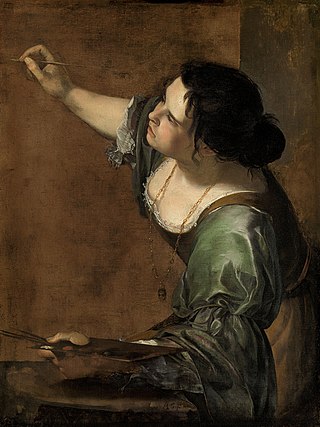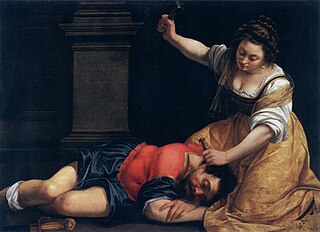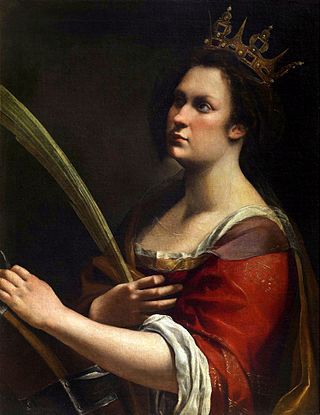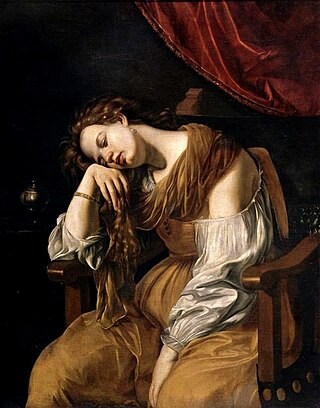
Artemisia Lomi or Artemisia Gentileschi was an Italian Baroque painter. Gentileschi is considered among the most accomplished 17th-century artists, initially working in the style of Caravaggio. She was producing professional work by the age of 15. In an era when women had few opportunities to pursue artistic training or work as professional artists, Gentileschi was the first woman to become a member of the Accademia di Arte del Disegno in Florence and she had an international clientele.

Orazio Lomi Gentileschi (1563–1639) was an Italian painter. Born in Tuscany, he began his career in Rome, painting in a Mannerist style, much of his work consisting of painting the figures within the decorative schemes of other artists.

Venus and Cupid (Sleeping Venus) is a circa 1626 painting by Artemisia Gentileschi in the Virginia Museum of Fine Arts. Venus and Cupid is a depiction of a sleeping Venus, who reclines on a blue bed covering and rich crimson and gold tasseled pillow. She wears nothing except a thin wisp of transparent linen around her thigh. Her son Cupid fans her with richly colored peacock feathers as she drifts to sleep. He is gazing at her with an adored, raptured expression. In the background, there is a window looking out onto a moonlight landscape where a temple to the goddess lies. Venus's face has full cheeks, heavy lids, a prominent nose, and small protruding chin—all features of Gentileschi's own face. The body movements are natural: Venus's hand rests lightly on her side, her legs are gently laid together. The work blends together realism and classicism through its iconography and the artist's style.

Susanna and the Elders is a 1610 painting by the Italian Baroque artist Artemisia Gentileschi and is her earliest-known signed and dated work. It was one of Gentileschi's signature works. She painted several variations of the scene in her career. It hangs at Schloss Weißenstein in Pommersfelden, Germany. The work shows a frightened Susanna with two men lurking above her while she is in the bath. The subject matter comes from the deuterocanonical Book of Susanna in the Additions to Daniel. This was a popular scene to paint during the Baroque period.

Judith and her Maidservant is a c. 1615 painting by the Italian baroque artist Artemisia Gentileschi. The painting depicts Judith and her maidservant leaving the scene where they have just beheaded general Holofernes, whose head is in the basket carried by the maidservant. It hangs in the Pitti Palace, Florence.
This is an ongoing bibliography of work related to the Italian baroque painter Artemisia Gentileschi.

Judith and Her Maidservant is one of four paintings by the Italian baroque artist Artemisia Gentileschi that depicts the biblical story of Judith and Holofernes. This particular work, executed in about 1623 to 1625, now hangs in the Detroit Institute of Arts. The narrative is taken from the deuterocanonical Book of Judith, in which Judith seduces and then murders the general Holofernes. This precise moment illustrates the maidservant Abra wrapping the severed head in a bag, moments after the murder, while Judith keeps watch. The other three paintings are now shown in the Museo di Capodimonte in Naples, the Palazzo Pitti in Florence, and the Musée de la Castre in Cannes.

Jael and Sisera is a painting by the Italian Baroque artist Artemisia Gentileschi, executed around 1620.

Self-Portrait as a Female Martyr, is also known as the Self-Portrait as a Martyr Saint. This painting was created by the Italian female artist, Artemisia Gentileschi. This self-portrait was made around 1615 depicting the artist herself as a martyr. It is one of two paintings by Gentileschi painted with oil on a wood panel. This self-portrait is currently in a private collection in the United States.

Santa Cecilia is an early painting, from c. 1620, by the Baroque painter Artemisia Gentileschi, a painter described as "a grand exception in the history of art - a successful woman painter in an era in which art was dominated by men."

Saint Catherine of Alexandra is a painting by the Italian Baroque artist Artemisia Gentileschi. It is in the collection of the Uffizi, Florence. Gentileschi likely used the same cartoon or preparatory drawing to create both this painting and the Self-Portrait as Saint Catherine of Alexandria (1615–1617), now in the National Gallery, London.

The Allegory of Painting is an painting from around the 1640s attributed in 1988 to the Italian Baroque artist Artemisia Gentileschi, although more recent research suggests it was painted by an anonymous Neapolitan painter in the mid-17th century. It is now in the Musee de Tesse, Le Mans, France.

The Portrait of a Gonfaloniere is a painting by the Italian baroque artist Artemisia Gentileschi. It hangs in the Palazzo d'Accursio, Bologna. It is a portrait of an unknown gonfaloniere standing in full regalia and was painted in 1622. Mary D. Garrard has speculated that the man may be Pietro Gentile of Genoa.

Penitent Magdalene is a painting by the Italian artist Artemisia Gentileschi. It hangs in Seville Cathedral. It has probably been in the cathedral since the late 17th century. She returned to the subject later in the 1620s in Mary Magdalene as Melancholy.

The Self Portrait of Italian baroque artist Artemisia Gentileschi was painted in the early 1630s. It currently hangs in the Palazzo Barberini, Rome. It is one of many paintings where Gentileschi depicts herself. Beyond self-portraits, her allegorical and religious paintings often featured herself in different guises.

The Birth of Saint John the Baptist, by Artemisia Gentileschi, was part of a six-painting portrayal of Saint John's life, with four of the paintings by Massimo Stanzione and one by Paolo Finoglia, for the Hermitage of San Juan Bautista on the grounds of Buen Rierto in Madrid, under orders from the Viceroy of Naples, the Conde de Monterrey. Although a date has not been agreed upon by scholars, Artemesia most likely painted The Birth of Saint John the Baptist between 1633 and 1635. It is one of the most renowned works from Artemisia's Naples period, especially due to its detailed rendering of fabrics and floor tiles.
Allegory of Inclination is a 1615-1617 oil on canvas painting by Artemisia Gentileschi on the ceiling of the Galleria in the Casa Buonarroti, in Florence. The painting depicts a young nude female seated in the heavens holding a compass. Her light-colored hair is elaborately styled and she is partially covered by swirling drapery. A star appears above her head.

The Finding of Moses is an early 1630s painting by Orazio Gentileschi. There are two versions, the prime version is in The National Gallery in London and the second is in Museo del Prado in Madrid.

Bathsheba is a 1636-37 painting by the Baroque painter Artemisia Gentileschi, with contributions by Viviano Codazzi and Domenico Gargiulo. It shows the Hittite woman Bathsheba being washed and tended to by her servants. At the top left of the painting, King David sees her from his palace. It was one of seven versions from the story of Bathsheba that Gentileschi painted.

















